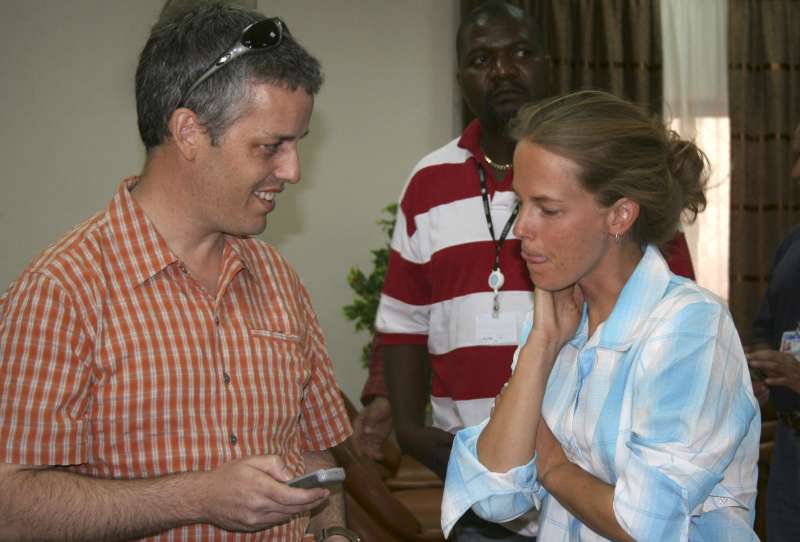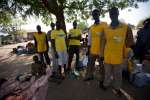Q&A: Canadian nurse speaks for the displaced through her art
News Stories, 27 September 2010
OTTAWA, Canada, September 27 (UNHCR) – Laura Archer hit world headlines last year when she was kidnapped and held for three days in Sudan's troubled Darfur region while working as a nurse for Médecins Sans Frontières (MSF), a valued partner for UNHCR. Today, the young Canadian is again making headlines – for her art. On October 9, an exhibition of her work, "Eyes on Darfur," opens at the Confederation Centre Art Gallery in Charlottetown on eastern Canada's Prince Edward Island. The striking portraits feature some of the forcibly displaced people she met in the deep field in the Sudan. They will be on display until December 23. Archer discussed her art and her humanitarian work with UNHCR Public Information Assistant Gisèle Nyembwe. Excerpts from the interview:
Tell us about your abduction.
In March 2009, I and four colleagues were kidnapped from our compound in North Darfur. It was a frightening experience for us as well as for our friends, families and colleagues. The most devastating result of this incident, unfortunately, is that MSF was forced to scale back activities in the area and now thousands of people have been left with no access to medical care.
Did your ordeal affect your willingness to help the needy in difficult areas?
My motivation to continue my humanitarian work has remained unaffected by the abduction. After all of the strength, hope and determination that I have seen in the eyes of IDPs [internally displaced people] and refugees, I refuse to become discouraged or to give up. Humanitarian workers face varying degrees of risk on a daily basis; this risk is something that I accepted when I began this work. One of the most frustrating aspects of my kidnapping ordeal was realizing how much of the media coverage was focused on me and on my experience – and not on the millions of people still being held hostage in Darfur and around the world.
How did it feel to have a safe home to return to?
It was wonderful to have a safe home and a supportive family to return to, but it was also extremely difficult to be forced to leave Darfur. I have always been aware of how fortunate and privileged I am, especially while working for months in refugee camps and conflict areas. I suppose this homecoming was more intense than usual.
Let's turn to your art. This is your second public exhibition.
My first exhibit, "Facing Africa," consisted of portraits of refugees and internally displaced people from Chad, Central African Republic and Democratic Republic of the Congo. It involved a lot of experimentation in terms of style. "Eyes on Darfur" consists solely of portraits of Darfurian IDPs. This show is much more cohesive than the first and I believe that my work has evolved dramatically since 2008. It is very exciting to have my work exhibited in a national gallery and I am hoping this exhibit will reach a larger audience.
Painting has become a second career for you. How did this start?
I first began painting in 2007 when I returned to Canada after a nine-month mission with Médecins Sans Frontières in Chad and Central African Republic [CAR]. My role involved supervising our outreach programme, working with locally hired community health workers and doing health education activities, vaccination campaigns and other activities. My role expanded gradually, and I had the opportunity to start up a programme relating to sexual violence and malnutrition. In CAR, I worked with a team conducting mobile clinics in very remote locations.
I had never painted before, but was compelled to find a creative way to share my experiences and, more importantly, to speak out on behalf of those who do not have a voice. I do not see a great distinction between the work that I do as a nurse and the work that I do as an artist; I feel that my art is an extension of my nursing and vice versa. The motivation behind both endeavours is to try and make a difference, no matter how small, in the world.
Why do you want to tell the stories of the refugees and IDPs you have met?
Refugees and IDPs are human beings, just like you and me. All too often, the media uses acronyms and statistics to describe what is happening on the ground. How can one relate to a statement like "2 million IDPs"? I believe that the first step in making change is compassion, which can only come from understanding. If more people hear personal stories, perhaps more people will be inspired to push for change. I recognize that my work – both as a humanitarian and as an artist – is not changing the situation or impacting the big picture. But what if one of the children we treated in one of our malnutrition clinics grows up to become a great leader? Everyone deserves that chance.
Why did you want to use your nursing skills overseas?
My first experience working as a nurse overseas was accidental. I was on a backpacking trip in Southeast Asia when the [Indian Ocean] tsunami of 2004 struck. I was immediately compelled to apply my nursing skills during that time and realized that I might have a role to play. When I returned home, I applied to work for MSF and have not looked back since.
Is there any experience that has particularly touched you?
It is impossible to choose just one particular experience. Every day working with refugees and IDPs is an honour and a privilege. I have had thousands of experiences that have touched me and that will stay with me forever. I am constantly amazed and humbled by the amount of courage, determination and compassion in the camps.
I have learned a lot of tough lessons along the way and will no doubt face more challenges down the road. It is my hope that I will be able to continue my humanitarian work and that I can have a small impact on the lives of refugees and IDPs.
Your field work must have brought you into contact with UNHCR
Although I had heard of UNHCR, I did not really understand what the organization does until I collaborated with the agency during my first mission with MSF in Chad in 2006. Quite often I would meet with UNHCR staff to discuss the well-being of refugees, to share information and to find ways of addressing challenges within the camp. For example, when new refugees arrived, UNHCR would be there to register the families and arrange for shelter, etc; we would be there to provide vaccinations and to address other medical concerns. I have had several other opportunities over the years to collaborate with UNHCR in the field and feel that mutual respect and cooperation between organizations are key factors in the successful provision of comprehensive and appropriate services to refugees and IDPs.
Where do you go from here?
I'm finishing the final painting for the "Eyes on Darfur" series. Once my exhibit officially opens on October 9, I plan to head back to the field with Médecins Sans Frontières. Where, when and for how long I will go will depend on the needs on the ground. I am also looking into artistic avenues through which I can continue my humanitarian work. One day at a time.























































